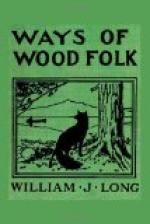One September afternoon, while walking quietly through the woods, my attention was attracted by an unusual sound coming from an oak grove, a favorite haunt of gray squirrels. The crows were cawing in the same direction; but every few minutes would come a strange cracking sound—c-r-r-rack-a-rack-rack, as if some one had a giant nutcracker and were snapping it rapidly. I stole forward through the low woods till I could see perhaps fifty crows perched about in the oaks, all very attentive to something going on below them that I could not see.
Not till I had crawled up to the brush fence, on the very edge of the grove, and peeked through did I see the performer. Out on the end of a long delicate branch, a few feet above the ground, a small crow was clinging, swaying up and down like a bobolink on a cardinal flower, balancing himself gracefully by spreading his wings, and every few minutes giving the strange cracking sound, accompanied by a flirt of his wings and tail as the branch swayed upward. At every repetition the crows hawed in applause. I watched them fully ten minutes before they saw me and flew away.
Several times since, I have been attracted by unusual sounds, and have surprised a flock of crows which were evidently watching a performance by one of their number. Once it was a deep musical whistle, much like the too-loo-loo of the blue jay (who is the crow’s cousin, for all his bright colors), but deeper and fuller, and without the trill that always marks the blue jay’s whistle. Once, in some big woods in Maine, it was a hoarse bark, utterly unlike a bird call, which made me slip heavy shells into my gun and creep forward, expecting some strange beast that I had never before met.
The same love of variety and excitement leads the crow to investigate any unusual sight or sound that catches his attention. Hide anywhere in the woods, and make any queer sound you will—play a jews’-harp, or pull a devil’s fiddle, or just call softly—and first comes a blue jay, all agog to find out all about it. Next a red squirrel steals down and barks just over your head, to make you start if possible. Then, if your eyes are sharp, you will see a crow gliding from thicket to thicket, keeping out of sight as much as possible, but drawing nearer and nearer to investigate the unusual sound. And if he is suspicious or unsatisfied, he will hide and wait patiently for you to come out and show yourself.
Not only is he curious about you, and watches you as you go about the woods, but he watches his neighbors as well. When a fox is started you can often trace his course, far ahead of your dogs, by the crows circling over him and calling rascal, rascal, whenever he shows himself. He watches the ducks and plover, the deer and bear; he knows where they are, and what they are doing; and he will go far out of his way to warn them, as well as his own kind, at the approach of danger. When birds nest, or




